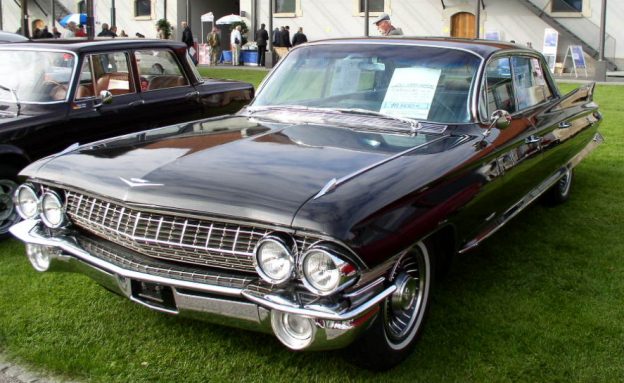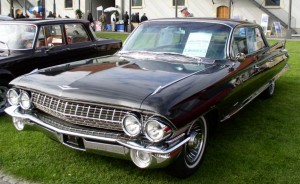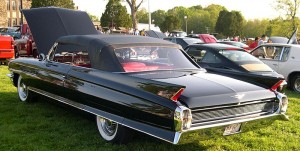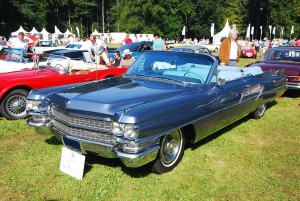A Cadillac print ad from 1964 touted the value of design continuity on its cars’ resale value. The photo showcased the ’64 model, with the 1960-1963 versions in the background. This was steadiness. This was predictability. Cadillac customers wanted that.
Lincoln, meanwhile, was essentially a bit player in the field, barely selling 25,000 cars a year in 1960 – a little more than a sixth of Cadillac’s volume. Even though the 1961 Lincoln Continental ushered in a new luxury car design paradigm with its clean slab-sided shape, sales remained barely above 30,000.
Cadillac, of course, had an all-new slab-sided design pending for 1965. But for the 1961-1964 period, America’s #1 luxury brand would ease its customers into the new design era gently. Leading the way was the Series 62, officially the 6200, but in any case not identified by an exterior badge.
When One Name Said It All
Before WWII, Cadillac had the right idea about branding its cars, identifying them by the marque name and not by model name. They were just known by “series.” The entry model for many years was the Series 61, with the Series 62 above it. Curiously, the Series 60 Fleetwood was above that. Go figure.
The Series 62 would remain the bedrock of the Cadillac brand through the 1950s. The Coupe DeVille, and then later Sedan DeVille, were at first upgrade models in the Series 62 range. In 1959, the DeVilles were moved to a separate Series 6300 range. The Series 6200, still called Series 62 by many, remained the entry range, although extra-cost options made them as luxurious as you wanted.
The 1950s, Continued
When Detroit’s 1961 models rolled into showrooms in the fall of 1960, the new Continental was in the spotlight as the new look of luxury. Its design would go on to influence even the Rolls-Royce Silver Shadow under development at the time.
Cadillac, however, which had dramatically toned down its fins and other decoration for the 1960 model year, really had a look that established instant identification. The brand would turn the page of design at its own pace.
For 1961, the Series 62 carried forth on the 129.5-inch wheelbase chassis, which was 6.5 inches longer than the Continental’s. That counted in rear-seat legroom, which Lincoln would address a few years later. Also, Cadillac continued with coil spring rear suspension, which many felt gave a better ride than the Lincoln’s leaf springs, a setup also used by Chrysler’s Imperial.
(1961 Series 62 Sedan. Photo by MartinHansV)
Cadillac’s signature tailfins were certainly lower than the towering monsters of 1959, but still long and pointy. The 1961, however, was not merely a restyled 1960 model; it was an all-new body on the previous chassis. Chuck Jordan had become Cadillac’s chief designer in late 1957. The 1959 design was finished done by then, and the 1960 work was a facelift – or cleanup – of that. Jordan, who was just 31 in 1958, had a chance to shape a new body for the ’61, with his assistant, Dave Holls.
You could say Cadillac took its fins defiantly into the new decade. On the ’61, these were joined by a new feature called skegs, a protruding lower body fin previewed by GM concept cars in the 1950s. The entire grille and front end were far tamer looking than the 1959-1960. The windshield was no longer the 1950s wraparound style, but was curved at the bottom, a feature also used on other GM cars.
Luxury, Cadillac Style
Beneath the Cadillac’s long hood, the 390 cu. in. V8 carried on, rated at 325-horsepower. The 1961 Cadillac Series 62 started at $5,080 – nearly $1,000 more than a Buick Electra or Oldsmobile 98. Options galore let you outfit a Cadillac to your exact tastes: air conditioning cost $474 (about $4,000 today!); the Autronic Eye automatic high-beam dimmer was $46; power windows were $85. Popular options were available in groups.
One of Cadillac’s numerous advantages over Lincoln was choice: there were pillarless four-window and six-window sedan styles, the hardtop coupe and a convertible. A short-deck (and short-lived) sedan had a shorter overall length to make parking easier.
(1962 Series 62 Convertible. Photo by Stephen Foskett)
Cadillac’s design was refined for 1962, with improved brakes among mechanical changes. For 1963 and 1964, the look was fully updated again, with the skegs erased and front fenders extended nearly five inches. The old Caddy V8 was refined for 1963 and then enlarged to 429 cu. in. for 1964. Cadillac continued to lead in luxury innovations, introducing thermostat-operated automatic climate control for 1964.
(1963 Series 62 Convertible. Photo by Janderk1968)
By then, however, Series 62 sales had dropped to 35,000 as more customers paid the upcharge for the fancier-trimmed DeVille models, which became Cadillac’s mainstay. When the 1965 Cadillacs debuted, the Series 6200 was replaced by the Calais as the entry model.
Why you’d want a 1961-1964 Cadillac Series 62
The great American luxury car.
A unique transitional model bridging 1950s and 1960s design.
A super-comfy cruiser for the car shows.
The convertible is a stunning head turner.



